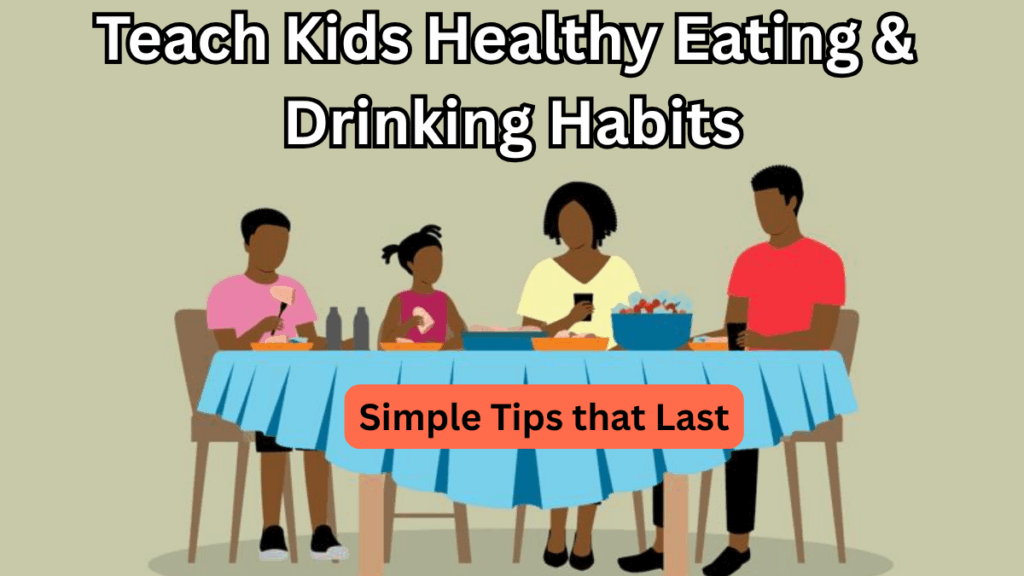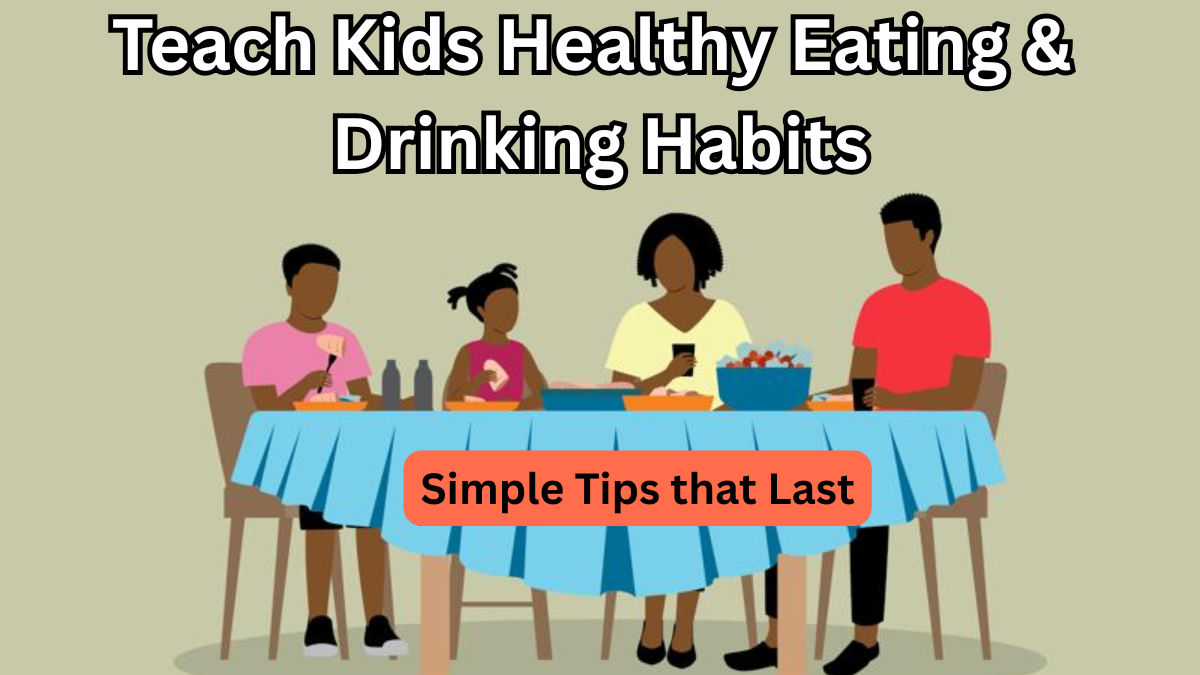Developing nutrition habits for children is one of the most meaningful investments we can make in their well-being. These habits shape their energy levels, immunity, mental focus, and even long-term health outcomes. But how do we get kids to enjoy broccoli and water more than soda and chips?
The answer lies in making food education enjoyable, consistent, and part of everyday family life. Let’s explore how to create a sustainable foundation for drinking water & healthy eating habits that truly stick.

Why Early Eating Habits Matter
The habits that children form during their formative years often become the blueprint for their adult choices. Early exposure to whole foods, proper hydration, and consistent mealtimes builds both body and mindset.
Long-Term Benefits of Early Healthy Habits:
-
Strengthened immunity and reduced illness
-
Enhanced brain development and school performance
-
Balanced growth and healthy weight maintenance
-
Less likelihood of chronic diseases later in life
By helping your child embrace nutrition habits for children early, you’re not just feeding them—you’re preparing them to thrive.
How to Make Healthy Eating Enjoyable for Kids
Kids don’t respond well to force, especially at the dinner table. Instead, make food fun, colorful, and engaging.
Practical Tips to Make Mealtime Enjoyable:
-
Let them build their own “mini meals” using healthy ingredients
-
Use cookie cutters for fun sandwich or fruit shapes
-
Pair new foods with their favorites to ease them in
-
Turn mealtime into a learning moment—talk about where food comes from
By removing pressure and adding creativity, you’re fostering a positive connection with food that naturally encourages healthy eating habits.
Encouraging Regular Water Intake
Water is often overlooked in children’s diets, yet it plays a crucial role in regulating temperature, aiding digestion, and keeping their energy levels up.
Why Kids Need to Stay Hydrated:
-
Prevents headaches, constipation, and fatigue
-
Supports metabolism and nutrient absorption
-
Keeps skin healthy and improves focus
Signs Your Child May Be Dehydrated
| Symptom | Possible Indicator |
|---|---|
| Dark-colored urine | Not enough water intake |
| Tiredness | Low energy or irritability |
| Dry lips and mouth | Visible dryness or cracking |
| Headaches | Especially during heat or exercise |
Simple Ways to Build a Water Habit:
-
Keep a colorful water bottle within reach at all times
-
Offer water before and after school, play, or meals
-
Add fruits like strawberries, lemon, or mint to water for flavor
-
Create a hydration tracker or sticker chart for fun rewards
These practices gently build drinking water & healthy eating habits into your child’s everyday routine.
Smart Snacking: Shifting to Nutritious Options
Snacks make up a big portion of a child’s diet, so steering them toward healthier options without eliminating the fun is key.
Smart Snack Swaps to Try:
| Instead of This… | Offer This Instead |
|---|---|
| Potato chips | Roasted chickpeas or air-popped popcorn |
| Sugary cereals | Oats with honey and sliced bananas |
| Ice cream | Frozen yogurt with real fruit |
| Candy | Raisins, dates, or fresh berries |
| Soda | Sparkling water with fruit slices |
Encouraging better snack choices is a crucial part of improving nutrition habits for children while still keeping them happy and satisfied.
Creating a Consistent Meal Routine
A predictable schedule helps your child understand when to expect meals and reduces unnecessary snacking. It also aligns with their internal body clock, improving digestion and sleep quality.
Sample Daily Nutrition Schedule:
| Time | Meal Type | Suggested Options |
|---|---|---|
| 7:30 AM | Breakfast | Whole-grain toast, peanut butter, banana, and milk |
| 10:00 AM | Mid-morning Snack | Apple slices with nut butter or a boiled egg |
| 1:00 PM | Lunch | Rice or roti, vegetables, and protein (chicken, dal, tofu) |
| 4:00 PM | Evening Snack | Smoothie with fruits and seeds |
| 7:30 PM | Dinner | Light soup or khichdi with steamed vegetables |
A consistent routine naturally reinforces drinking water & healthy eating habits without stress or conflict.
Let Them Be Involved in Food Choices
Children are more likely to try something they’ve helped make or select. Involving them in age-appropriate kitchen tasks or shopping can teach them essential life skills.
Activities to Encourage Food Awareness:
-
Let them choose one new fruit or vegetable at the store
-
Assign simple cooking tasks like mixing or washing
-
Teach them how to pack their own lunchbox
-
Discuss food origins and how it benefits the body
These hands-on experiences make nutrition habits for children something they own, not something imposed.
Model Healthy Behaviors
Kids absorb behaviors more than words. If they see you drinking water regularly, choosing fruits, or enjoying home-cooked meals, they’re more likely to mimic those choices.
Set the Right Example By:
-
Eating meals as a family as often as possible
-
Avoiding screens during meals to focus on the food
-
Speaking positively about all types of food
-
Practicing moderation rather than restriction
Your consistent modeling will silently teach drinking water & healthy eating habits more effectively than lectures ever could.
Building a Healthy Relationship With Food
Avoid using food as a punishment or reward, which can lead to emotional eating patterns later in life. Instead, teach children to listen to their bodies and understand hunger versus boredom.
Ways to Promote a Balanced Food Mindset:
-
Respect when your child says they’re full
-
Don’t label food as “good” or “bad”—focus on frequency
-
Talk about how different foods help the body (e.g., carrots help eyesight)
-
Keep desserts and treats in moderation without shaming
A child who trusts their hunger and enjoys a variety of foods is well on their way to building lifelong healthy habits.
FAQs: Healthy Eating & Drinking for Children
1. How much water does a child need daily?
It varies by age and activity level. On average:
-
Toddlers (1–3 years): 4 cups
-
Ages 4–8: 5 cups
-
Ages 9–13: 7–8 cups
Encourage small, frequent sips throughout the day rather than large gulps at once.
2. How can I reduce sugar intake without creating resistance?
Start gradually. Replace sugary cereals and snacks with naturally sweet foods like fruit or yogurt with honey. Explain why it’s better for energy and teeth without using scare tactics.
3. What if my child refuses vegetables completely?
Be patient. Serve veggies in different ways (soups, smoothies, dips). Involve them in meal prep. Most importantly, keep offering without pressure—it often takes multiple exposures.
4. Are occasional junk foods okay?
Yes, balance is key. Occasional treats are fine when the overall diet is balanced. Use them as part of meals instead of standalone rewards to avoid emotional connections.
Final Thoughts
Nurturing nutrition habits for children doesn’t have to be overwhelming. It’s about making small, consistent choices each day—replacing one sugary drink with water, trying one new vegetable a week, or simply sitting down together for meals.
Your support, patience, and example play the biggest role in helping kids embrace drinking water & healthy eating habits that empower them for life. Think of it as planting seeds of health—what you nurture today will bloom tomorrow.
Click here to learn more
